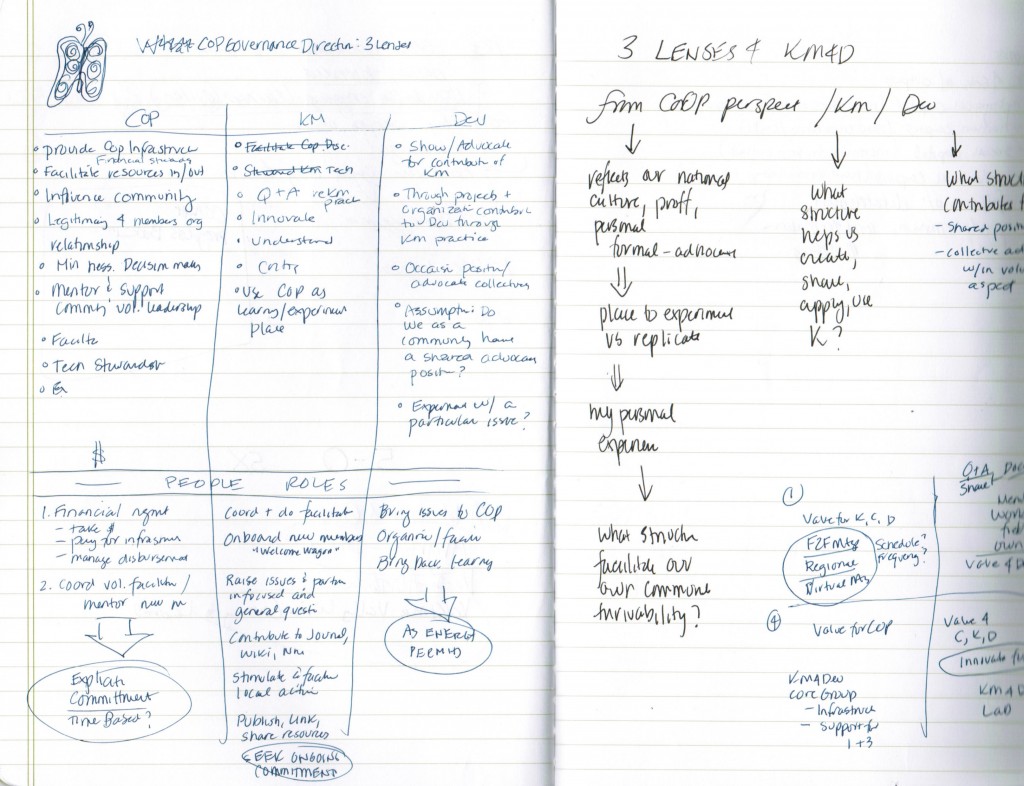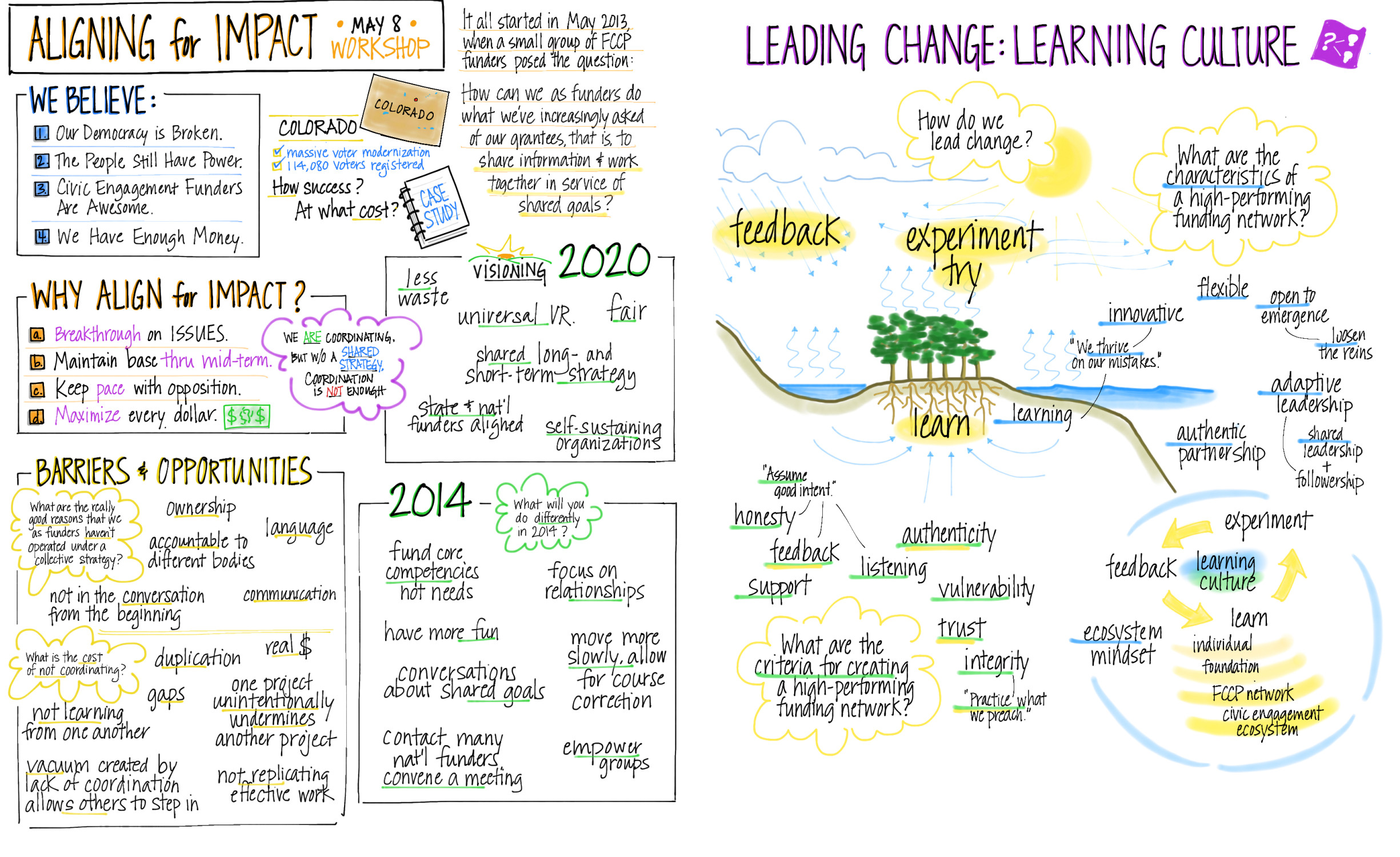Warning: LONG thinking-out-loud post! And note, the best stuff is in the comments!
For the last month or so there have been some very interesting conversations on the KM4Dev email discussion. One of them has been a reflection on the governance of KM4Dev, particularly the role of the current Core Group and the overall business model. KM4Dev has been around for over 10 years and grown to be a vibrant and respected community. It certainly is one of my very central communities of practice and I love and fret over it a lot. I was on the Core group from its inception until about 18 months ago when I stepped out, partly from burnout, partly from frustration, but keenly aware that my “just do it” attitude had longer term ramifications of people expecting me and the other “do-ers” to, well, just get it done. That is dis-empowering. (And I can be, um, a little dominating? 🙂 ) Now, back to the question of governance.
This begs the question, what kind of animal IS KM4Dev? A community of practice (CoP)? A loose, affiliated network of people interested in KM in development? A service? How should this inform our choices? Are there sufficient distinctions in the governance and supporting infrastructure of a larger network, versus a more bounded community? Or is it more dependent on the nature of that community or network?
As I read the messages, there were those who advocated a strong group for governance, for a paid secretariat staff. For formality. Others suggested developing multiple local offshoots and centralize the support functions in those volunteer hubs. From ideas for spin offs that embrace diverse business models, pleas for funding, to a very open, “let it be” model, all struck me as models that reflected each person’s world view. Some fundamentally urged the group to become more of an advocate for KM in development as a community, while others kept a more CoP-traditional perspective of the group as a place for its own learning. Do academics prefer more formality? What causes people to think paid positions are more generative for the community than volunteering? Are there ramifications beyond reliability? SOOOO many things to consider.
I then sent the following message to the group (this is just part of the message. It was a rambly, early morning thing!):
Here is my perception (NOT FACT) Those of us who prefer structure and some degree of formality discussed more about governance and secretariat (and I suppose, have a clearer idea about that differentiation. It is not a language used outside of development much here in the US!) Those of us who prefer informality (or perhaps, just fleeing too much structure!) emphasize the more emergent and adhoc options. Those who are taking a strong community lens focus on the community aspects of volunteerism and self organization. Those with a KM lens, (which in fact, have not stood out in my memory of reading these threads — INTERESTING) advocate for structures which focus on KM and finally, some have advocated structure that in fact advocates for international development.
How do we find your way forward with all these options? Furthermore, how do you discern options where people will “walk their talk” and pick up leadership. It is all nice and good to say “YOU should do this or that.” But in the end, if no one in the community is willing to step up to the tasks, all is probably lost. If no one cares enough to value and use what is provided – paid or not, what is it worth?
Consider this: if you look at the number of people posting in the thread (less than 20?) compared to the list of members on the email list and/or our NING site (2500+), how do you reconcile the individual advocacy for a particular path forward with the huge, silent, larger whole? To whom does this “governance” thing matter? Is it important to those who simply see KM4Dev as an email list they can dip into when they need it – a sort of service? To those who avidly read, but rarely or never post for a host of reasons? To those of us who perhaps love KM4dev too much? 🙂
So I started doodling. Is it useful to examine our governance and structure questions from a variety of lenses, and then find out if there is a sweet spot between them? From the conversation I discerned three possible lenses or perspectives including: Community, KM (in development) and Advocacy for KM in Development. Here is what I sketched on my notebook.

For example, philosophically I absolute love the idea that KM4Dev should be more altruistic and more actively serve development. The realist in me says this is a structural mismatch, that indeed, by focusing on community and KM, we become stronger agents of that wider change through other, more formalized structures (of our orgs, etc) and we become INFLUENCERS as a network. But that does not exclude forays into advocacy. The lenses do not imply “either/or” but simply help us explore from a variety of perspectives. Here is a very imperfect first try and looking across the three example lenses :

If I look across the three, there is less difference between the community lens and the domain lens, while the advocacy lens presents unique benefits and needs. As noted above, it looks to be a far stretch for KM4Dev to pull that off. That said, KM4Dev might be an amazing incubator for a more focused group working on the advocacy.
So the next level of resource implications are about the degree of importance KM4Dev activities and artifacts have to be polished to the level of acceptance by development organizations and practitioners outside of the community. In other words, legitimacy beyond the community. This seems to require more infrastructure and thus more refined business models (funding) and processes.
So the question is, what does the community want and what can it pull off. And I’d personally add, how does it differentiate itself from yet another organization?
Help me improve my thinking.
P.S. If you look back up to the first image, you will see some scribbling on the lower right of the notebook sketch. I’ll post about that in the next blog post. Stay tuned for Part 2 of Nancy’s Ramblings….





